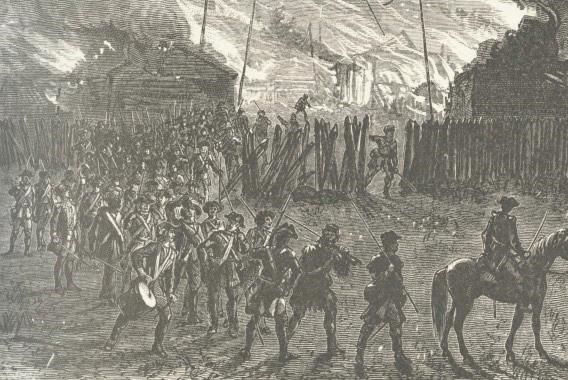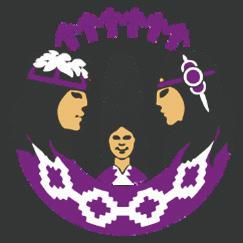
4 minute read
Death, economic ruin and depopulation during the Sullivan-Clinton genocide against the Haudenosaunee
The Sullivan-Clinton Campaign against the Six Nations Iroquois Confederacy in 1779 was a devastating genocidal attack against the Haudenosaunee people — the ends of which are still felt in Haudenosaunee communities to this day.
Although the Iroquois nations had officially declared neutrality during the Seven Years War between Britain, France and Spain — and the war concluded with the Treaty of Paris in 1763 — tensions were rising between British loyalists and American rebels along the Mohawk Valley around 1775 in what would soon become the Revolutionary War.
The British knew that they needed the help of indigenous warriors in order to fight. A Grand Council was called at Montreal between the British and as many “Canadian” Indians as they could rally. It was held in Montreal from July 26-29, 1775 and included 1700 Indigenous representatives — from the Caughnawagas, the Mississaugas, the Seven Nations of Canada (the Mohawks of Akwesasne, Kahnawake, Kanesatake, Oswegatchie; and the Abenakis, Mi’kmaqs and Hurons of Odonak, Becancour and Jeune Lorette) and the Six Nations Iroquois of the Mohawk Valley.
It was at this Great Council in Montreal, 1775, where Sir Guy Carleton, then Governor General of British North America, made a promise to all those nations in attendance. Joseph Brant said, “Upon our arrival there [Montreal], this conduct was approved of by Sir Guy Carleton, who, in a public Council, desired us to take up the hatchet and defend our country, and that any losses we might sustain by the war, he promised should be replaced.”
It was because of this promise made, guaranteeing the people would see restoration for any losses, that the Six Nations felt confident supporting the British in their war effort.
But the devastation of the Sullivan-Clinton genocide was massive.
In 2018, a study by Rhiannon Koehler outlined the economic impacts of the Sullivan-Clinton genocide against the Six Nations.
In June 1778, US Congress voted to allocate $932,743 toward the genocidal campaign against the Six Nations — an estimate 85% of the total US governments budget.
The campaign included a military mobilization against Iroquois and British people in the Mohawk Valley, but also included an initial propaganda blitz, including fake news stories about grotesque attacks carried out on American rebel families and villages that either never took place at all or were in some cases done by people in disguise, dressed as Iroquois warriors — creating a pandemonium of fear amongst the already war strained settlers in the Mohawk Valley.
In 1779, General George Washington brought together Generals John Sullivan, James Clinton, Horatio Gates and
Colonels Daniel Brodhead and Goose van Schaick to design a plan of attack to absolutely destroy the homes and lives of all of the Indigenous people of the Six Nations Iroquois Confederacy in the Mohawk Valley.
One of the first attacks against the Confederacy came against the village of Onaquaga. Historical records show that the village was completely burnt to the ground by American rebel militas, destroying all but one of the houses there. Militia men are noted in the historical records as attacking the village, impaling young children in the village with bayonets and torturing them as they died.
In response, Haudenosaunee warriors and British soldiers raided the town of Cherry Valley and killed 14 people, captured 11 people and wounded 5.
In the propaganda coming out of the day however — the Cherry Valley event was promoted as ‘the most devastating massacre of the entire American Revolution’ while the genocide against Onaquaga, murder and torture of indigenous children there, along with the devastation of the homes and economy in that village was never quantified or publicized.
Early estimates of the population of Onaquaga prior to its destruction homes of the Iroquoian people from April 1779 through to September 1779 a total of 16 separate days of destruction are recorded included the burning down of more than 579 houses, an indeterminate number of tents, and the burning of Cayuga castle. There are entire days that were spent by soldiers collecting and burning homes and crops, destruction of cheese, food storage facilities, wine and rum. In the Seneca town of Chenussio alone, 128 houses were set ablaze along with all of the contents within it. icated to the collection of crops, seeds, farming implements and more and their subsequent burning and destruction. are between 700-1000 people. Because of its location, southeast of the Finger Lakes on the Susquehanna and Delaware Rivers it was a central trading hub for the entire region and because that trading hub was controlled by Oneidas and Tuscaroras for over half a century it was a major stronghold for the Iroquois economy.
On one day, 9 boatloads of vegetables and corn were taken from Haudenosaunee homes and given to American troops from a village under siege. Ten acres of crops there were then destroyed.
On another day, 200 acres of corn were destroyed along with orchards, gardens and 8 towns burned to the ground.
The death tally recorded is a grievous account.
But by the time the Six Nations had fled the Mohawk Valley and sought refuge along the Grand River, the Onaquagas listed in the records of Sir Fredrick Haldimand from 1784 number just 162. Though it is not noted where the bulk of the Onaquagas went to after the American Revolution it is known that the Six Nations population was decreased by 50% by the end of the war — a direct result of the Sullivan-Clinton genocide. Anthony F.C. Wallace, an anthropologist who looked at the effects of the campaign against the Iroquois wrote that nearly 4500 people died in the campaign.
In 1779, 5036 Six Nations people had arrived at Fort Niagara as refugees fleeing the genocide. Through that winter, another 20% are estimated to have died due to starvation, freezing or illness.
The destruction of the
The lands and food destroyed in the campaign is noted across 18 days of dedicated destruction including the burning of all the cornfields and orchards at Onaquaga and 35,000 bushels of corn. That is enough corn to line the streets from the village of Ohsweken to Toronto.
The villages of Onoquaga, Chenago, Oswego, Big Flats, Oneida, Appleton, Delaware village, Conawauga village, Concuss, Kershong and more are noted as “destroyed”
Entire days were ded-
On July 27, 1779 over 121 Haudenosaunee people were killed. On October 6, 1779 over 200 Haudenosaunee people were killed.
In total, it is noted that the American military recorded the deaths of up to 580 Haudenosauee people. However the actual population losses are estimated to be up to 4500 Haudenosaunee people including those killed by the military, those who starved, who died during their escape to Fort Niagara and the starvation, sickness and more.











